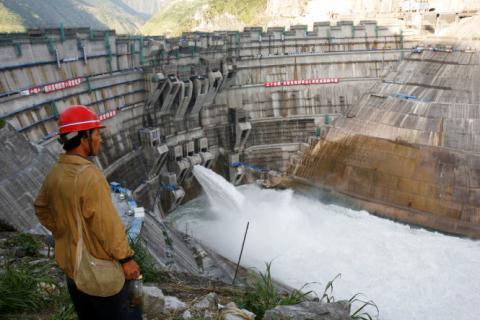Brian Eyler, director of the Southeast Asia Program at the Stimson Center, said at a workshop discussing the possible impact of Chinese policies on the Mekong River some days ago that China has built hydropower dams on the Mekong not to generate electricity, but to store water for the future.

In the lower course, about 400 hydropower dams are about to be built, of which 300 would be built by Laos. China will be the investor of the projects, together with Thailand.
According to Dr Duong Van Ni from the Can Tho University, when building hydropower dams, countries aim for several goals: generating power, storing water, lowering the temperature in the areas, raising the water level for easy navigation, exploiting waterways transport, and creating landscapes for tourism development.
| To date, China has completed 11 hydropower dams out of total 19 dams in the upper course of Mekong. |
Chinese hydropower dams in the upper course of Mekong have two major consequences to Vietnam.
First, Vietnam will lack alluvium, especially raw sediments (such as sand). They also lead to changes in the hydrological regime downstream.
“Vietnam’s Mekong Delta is lacking sand and there is no alternative source,” Ni said.
“In the past, water came in July. But nowadays, the hydropower dams in the upper course have changed, ” he said, adding that early or later arrival of water affects biodiversity.
“When water comes, fish will come with water flow in the migration and egg laying season. However, as the hydropower dams have changed, many fish cannot adapt to the changes and they are facing the risk of going extinct. These are unavoidable consequences that Vietnam needs to anticipate,” he explained.
Eyler said Vietnam needs to discuss the issue with China, because the Mekong Delta needs floods to develop. As for the hydropower dams in the lower course, Eyler said Vietnam should negotiate with Laos and Cambodia on the reduction of the number of hydropower dams.
Vietnam is considered a big electricity buyer in the region, so it is in a good position to discuss with Laos and Cambodia the development of clean energy such as wind and solar power.
Ni doesn’t fully agree with the suggestion by the US expert. He believes that the decline in fish output is the biggest impact of the Lao and Cambodian hydropower dams.
He pointed out that Lao and Cambodian hydropower dams will make the drought and flood more serious. In dry season, hydropower plants store water. In rainy season, the plants discharge water, causing serious floods in Mekong Delta.
Kim Chi

Laos builds more hydropower dams, sparking concern in Vietnam
The International and Vietnam Mekong Commissions have protested, but Laos is implementing its plan to build more hydropower dams on the Mekong mainstream, reported Saigon Economic Times.
 To date, China has completed 11 hydropower dams out of total 19 dams in the upper course of Mekong." itemprop="description" />
To date, China has completed 11 hydropower dams out of total 19 dams in the upper course of Mekong." itemprop="description" />
